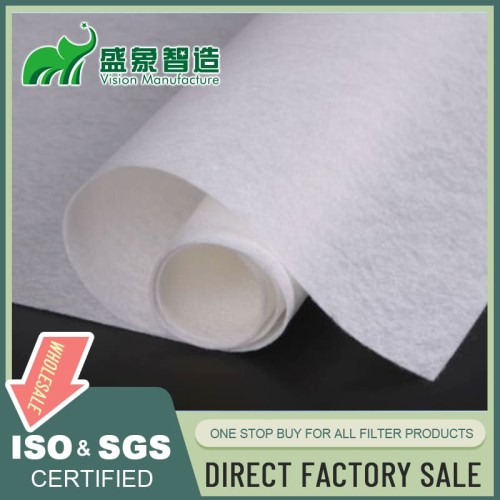
PTFE Filter Cloth: Advanced Filtration for Challenging Industrial Environments
I. Introduction
PTFE (Polytetrafluoroethylene) filter cloth is renowned for its exceptional performance in industrial filtration, offering unique properties that make it indispensable in modern industrial processes. This section provides an overview of PTFE's role in filtration and its significance in enhancing operational efficiency and compliance with environmental standards.
II. Properties of PTFE Filter Cloth
- Chemical Resistance: PTFE exhibits outstanding resistance to a wide range of chemicals, making it ideal for harsh environments.
- Temperature Tolerance: Capable of withstanding extreme temperatures, PTFE maintains performance stability under varying thermal conditions.
- Non-stick Characteristics: The surface of PTFE cloth prevents substances from adhering, facilitating easier cleaning and maintenance.
- Hydrophobic Nature: PTFE's ability to repel water enhances its suitability for wet applications and moisture-laden environments.
- Durability and Longevity: Highly durable, PTFE withstands wear and tear, offering a long service life even in demanding applications.
III. Manufacturing Process
- PTFE Fiber Production: The creation of PTFE fibers involves specialized processes that ensure high strength and uniformity.
- Weaving Techniques: Advanced weaving techniques are employed to produce cloths with precise pore sizes and consistent quality.
- Membrane Lamination (if applicable): Laminating PTFE membranes onto substrates enhances filtration efficiency and mechanical strength.
- Surface Treatments and Finishes: Surface modifications can be applied to meet specific filtration performance requirements.
IV. Types of PTFE Filter Cloth
- Woven PTFE Fabric: Utilized for its robust mechanical properties and uniform weave patterns.
- Needle Felt PTFE: Offers excellent depth filtration capabilities.
- PTFE Membrane-laminated Fabrics: Provide superior barrier properties and enhanced filtration efficiency.
- Expanded PTFE (ePTFE) Cloths: Feature a microporous structure that delivers high breathability and fine filtration.
V. Applications Across Industries
PTFE filter cloth serves critical roles in various sectors:
- Chemical Processing: Essential for filtering aggressive chemical agents.
- Pharmaceutical Manufacturing: Ensures contaminant-free conditions in drug production.
- Food and Beverage Production: Used in applications requiring high purity and regulatory compliance.
- Power Generation: Filters flue gases and other emissions effectively.
- Waste Incineration: Captures toxic particulates and gases.
- Mining and Minerals Processing: Handles abrasive materials and harsh conditions.
VI. Performance Characteristics
- Filtration Efficiency Ratings: PTFE cloth achieves high filtration ratings, effectively capturing fine particulates.
- Flow Rate Capabilities: Maintains optimal flow rates, preventing system strain.
- Particle Retention: Excellent at retaining captured particles, reducing contamination risks.
- Pressure Drop Profiles: Designed to minimize pressure drops, enhancing system efficiency.
- Cake Release Properties: The non-stick surface facilitates easy removal of filter cakes.
VII. Design Considerations
- Cloth Thickness and Weight: Tailored to specific application needs to balance filtration efficiency and permeability.
- Pore Size and Distribution: Engineered to provide precise filtration levels.
- Surface Treatments for Enhanced Performance: Treatments can be applied to improve dust cake release and cleanability.
- Integration with Support Structures: Ensures compatibility with existing filtration systems.
VIII. Installation and Usage
- Proper Handling Techniques: Essential to maintain the integrity of the cloth during installation.
- Installation Best Practices: Ensures optimal fit and function within the filtration system.
- Break-in Procedures: Prepares the cloth for operation, optimizing performance.
- Monitoring During Operation: Essential for maintaining efficiency and detecting issues early.
IX. Maintenance and Cleaning
- Inspection Routines: Regular checks to ensure the cloth is functioning properly.
- Cleaning Methods and Frequency: Guidelines for effectively cleaning the cloth to maintain performance.
- Regeneration Techniques: Methods to restore filtration efficiency.
- Replacement Guidelines: Criteria for replacing the cloth to ensure continuous system performance.
X. Advantages Over Traditional Filter Materials
- Superior Chemical Resistance: Offers unmatched durability in chemically aggressive environments.
- Extended Service Life in Harsh Environments: Reduces the frequency of replacements.
- Improved Cake Release and Cleaning Efficiency: Enhances operational efficiency and reduces downtime.
- Consistent Performance at High Temperatures: Maintains effectiveness across a range of thermal conditions.
XI. Environmental and Safety Considerations
- Emissions Reduction Capabilities: Significantly lowers particulate and chemical emissions.
- Energy Efficiency in Filtration Processes: Reduces energy consumption due to lower pressure drops and improved airflow.
- Workplace Safety Improvements: Enhances air quality, contributing to a safer work environment.
- Disposal and Recycling Practices: Focuses on sustainable disposal and recycling of used filter materials.
XII. Case Studies
Real-world applications demonstrate the effectiveness of PTFE filter cloth in various settings, showcasing its ability to solve complex filtration challenges and deliver significant improvements in performance and operational efficiency.
XIII. Technological Advancements
- Nanofiber-enhanced PTFE Cloths: Innovations that improve filtration efficiency.
- Smart PTFE Fabrics with Sensing Capabilities: The integration of technology to monitor and optimize filtration processes.
- Hybrid Materials Combining PTFE with Other High-performance Fibers: Enhances mechanical properties and filtration performance.
- Sustainable Manufacturing Practices for PTFE Products: Focuses on reducing environmental impact during production.
XIV. Conclusion
PTFE filter cloth is a cornerstone of modern industrial filtration, offering numerous benefits across various applications. As filtration technology evolves, this material continues to play a crucial role in enhancing system performance and meeting environmental standards. For industries looking to optimize their filtration processes, PTFE filter cloth offers a reliable and cost-effective solution.
Leave a comment

